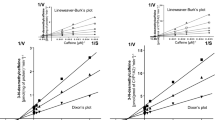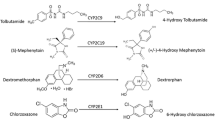Summary
The calcium channel blocker verapamil[2,8-bis-(3,4-dimethoxyphenyl)-6-methyl-2-isopropyl-6-azaoctanitrile] is widely used in the treatment of hypertension, angina pectoris and cardiac arrythmias. The drug undergoes extensive and variable hepatic metabolism in man with the major metabolic steps comprising formation of D-617 [2-(3,4-dimethoxyphenyl)-5-methylamino-2-isopropylvaleronitrile] and norverapamil [2,8-bis-(3,4-dimethoxyphenyl)-2-isopropyl-6-azaoxtanitrile]. The enzymes involved in metabolism of verapamil have not been characterized so far. Identification of these enzymes would enable estimation of both interindividual variability in verapamil metabolism introduced by the respective pathway and potential for metabolic interactions. We therefore characterized the enzymes involved in formation of D-617 and norverapamil.
The maximum rate of formation of D-617 and norverapamil was determined in the microsomal fraction of 21 human livers which had been previously characterized for the individual expression of various P450 enzymes (CYP1A2, CYP2C, CYP2D6, CYP2E1 and CYP3A3/4) by means of Western blotting. Specific antibodies directed against CYP3A were used to inhibit formation of D-617 and norverapamil. Finally, formation of both metabolites was investigated in microsomes obtained from yeast cells which were genetically engineered for stable expression of human P450.
Formation of D-617 was correlated with the expression of CYP3A (r=0.85; P<0.001) and CYP1A2 (r=0.57; P<0.01) in the microsomal fraction of 21 human livers after incubation with racemic verapamil. Formation of norverapamil was correlated with the expression of CYP3A (r=0.58; P<0.01) and CYP1A2 (r=0.5; P<0.05) in the same preparations after incubation with racemic verapamil. Antibodies against CYP3A reduced maximum rate of formation of D-617 (to 37.1±11% and 40.6±6.801o of control after incubation with S- and R-verapamil, respectively) and norverapamil (to 38.2±4.5% and 29.2±5.5% of control after incubation with S- and R-verapamil, respectively). Both D-617 and norverapamil were formed by stable expressed CYP3A4 (16.6 pmol/mg protein/min and 22.6 pmol/mg protein/min, respectively). In summary, formation of D-617 and norverapamil is catalyzed mainly by CYP3A4. D-617 is also formed by CYP1A2. Veraparnil therefore has the potential to interact with other drugs which are substrates or inducers of CYP3A and CYP1A2.
Similar content being viewed by others
References
Ayesh R, Kroemer HK, Eichelbaum M, Smith RL (1991) Metabolism of verapamil in a family pedigree with deficient N-oxidation of trimethylamine. Br J Clin Pharmacol 31:693–696
Barbarash RA, Baumann JL, Fischer JH, Kondos GT, Batenhorst RL (1988) Near total reduction in verapamil bioavailability by rifampicine. Chest 94:954–959
Bolognesi R (1991) The pharmacological treatment of atrial fibrillation. Cardiovasc Drug Ther 5:617–628
Botsch S, Gautier JC, Beaune P, Eichelbaum M, Kroemer HK (1993) Identification and characterization of the cytochrome P450 enzymes involved in N-dealkylation of propafenone: molecular base for interaction potential and variable disposition of active metabolites. Mol Pharmacol 43:120–126
Brain WR, Sari MA, Iwasaki M, Shimada T, Kaminsky LS, Guengerich FP (1990) Catalytic activities of human liver cytochrome P-4503A4 expressed sacharomyces cerevisiae. Biochemistry 29:11280–11292
Cashman JR (1989) Enantioselective N-oxygenation of verapamil by hepatic flavin-containing monooxygenase. Mol Pharmacol 36:497–503
Eichelbaum M, Ende M, Remberg G, Schomerus M, Dengler HJ (1978) The metabolism of DL[14C]-verapamil in man. Drug Metab Dis 7:145–148
Fuhr U, Woodcock BG, Siewert M (1992) Verapamil and drug metabolism by cytochrome P450 isoform CYP1A2. Eur J Clin Pharmacol 42:463–464
Gonzalez FJ (1989) The molecular biology of cytochrome P450s. Pharmacol Rev 40:243–288
Gross AS, Mikus G, Mörike K, Eichelbaum M (1990) Pharmacokinetics and pharmacodynamics of the enantiomers of gallopamil. Eur J Pharmacol 183:1651–1652
Guengerich FP, Darman GA, Wright ST, Martin MV, Kaminsky LS (1982) Purification and characterization of liver microsomal cytochrome P450: electrophoretic, spectral, catalytic and immunochemical properties and inducibility of eight isozymes isolated from rats treated with phenobarbital or naphtoflavone. Biochemistry 21:6019–6030
Guengerich FP, Turvy CG (1991) Comparison of levels of several human microsomal cytochrome P-450 enzymes and epoxide hydrolase in normal and disease states using immunochemical analysis of surgical liver samples. J Pharmacol Exp Ther 256:1189–1194
Kroemer HK, Echizen H, Heidemann H, Eichelbaum M (1992) Predictability of the in vivo metabolism of verapamil from in vitro data: contribution of individual metabolic pathways and stereoselective aspects. J Pharmacol Exp Ther 260:1052–1057
Kronbach T, Fischer V, Meyer UA (1988) Cyclosporine metabolism in human liver: identification of cytochrome P 450III gene family as the major cyclosporine-metabolizing enzyme explains interactions of cyclosporine with other drugs. Clin Pharmacol Ther 43:630–635
Lindholm A, Henrissons S (1987) Verapamil inhibits cyclosporine metabolism. Lancet 1:1262–1263
Lowry OH, Rosebrough NJ, Farr AL, Randall RJ (1951) Protein measurement with Folin phenol reagent. J Biol Chem 193:265–275
Lubet A, Meyer RT, Cameron JW, Nims RW, Burke MD, Wolff T, Guengerich FP (1985) Dealkylation of pentoxyresorufin: a rapid and sensitive assay for measuring induction of cytochrome(s) P-450 phenobarbital and other xenobiotics in the rat. Arch Biochem Biophys 238:43–48
Maurice M, Pichard L, Daujat M, Fabre I, Joyeux H, Domergue J, Mantel P (1992) Effects of imidazole derivatives on cytochromes P450 from human hepatocytes in primary cultures. FASEB J 6:752–758
McTavish D, Sorkin EM (1989) Verapamil. An updated review of its pharmacodynamic and pharmacokinetic properties, and therapeutic use in hypertension. Drugs 38:19–76
Meier PJ, Müller HK, Dick B, Meyer UA (1983) Hepatic monooxygenase activities in subjects with genetic defect in drug oxidation. Gastroenterology 85:682–692
Mikus G, Eichelbaum M, Fischer C, Gumulka S, Klotz U, Kroemer HK (1990) Interaction of verapamil and cimetidine: stereochemical aspects of drug metabolism, drug disposition and drug action. J Pharmacol Exp Ther 253:1042–1048
Namkung MJ, Yang HL, Hulla JE, Juchau MR (1988) On the substrate specificity of cytochrome P450IIIA 1. Mol Pharmacol 34:628–637
Nelson WL, Olson LD, Beitner DB, Pallow JR (1988) Regiochemistry and substrate stereoselectivity of O-demethylation of verapamil in the presence of the microsomal fraction from rat and human liver. Drug Metab Dis 16:184–188
Nielsen-Kudsk JE, Buhl JS, Johanessen AC (1990) Verapamil-induced inhibition of theophylline in healthy humans. Pharmacol Toxicol 66:101–103
Omura T, Sato R (1964) The carbon monoxide binding pigment of liver microsomes. J Biol Chem 239:2370–2378
Rutledge DR, Pieper JA, Mirvis DM (1988) Effects of chronic phenobarbital on verapamil disposition in humans. J Pharmacol Exp Ther 246:7–13
Sesardik D, Boobis AR, Murray BP, Murray S, Segura J, de la Torre R, Davies DS (1990) Furafylline is a potent and selective inhibitor of cytochrome P 4501 A2 in man. Br J Clin Pharmacol 29:651–663
Shimada T, Misono KS, Guengerich FP (1986) Human liver microsomal cytochromes P450 mephenytoin 4-hydroxylases a prototype of genetic polymorphism in oxydative drug metabolism. Purification and characterization of two similar forms involved in the reaction. J Biol Chem 261:909–921
Towbin HH, Staehelin T, Gordon J (1979) Electrophoretic transfer of proteins from polyacrylamide gels to nitrocellulose sheets: procedure and some applications. Proc Natl Acad Sci USA 76: 4350–4354
Trohman RG, Estes DM, Castellanos A et al (1986) Increased quinidine plasma concentrations during administration of verapamil: a new quinidine — verapamil interaction. Am J Cardiol 57:706–707
Watkins PB, Wrighton SA, Maurel P, Schuetz EG, Mendez-Picon G, Parker GA, Guzelian PS (1985) Identification of an inducible form of cytochrome P450 in human liver. Proc Natl Acad Sci USA 83:6310–6314
Author information
Authors and Affiliations
Additional information
Correspondence to H. K. Kroemer at the above address
Rights and permissions
About this article
Cite this article
Kroemer, H.K., Gautier, JC., Beaune, P. et al. Identification of P450 enzymes involved in metabolism of verapamil in humans. Naunyn-Schmiedeberg's Arch Pharmacol 348, 332–337 (1993). https://doi.org/10.1007/BF00169164
Received:
Accepted:
Issue Date:
DOI: https://doi.org/10.1007/BF00169164




